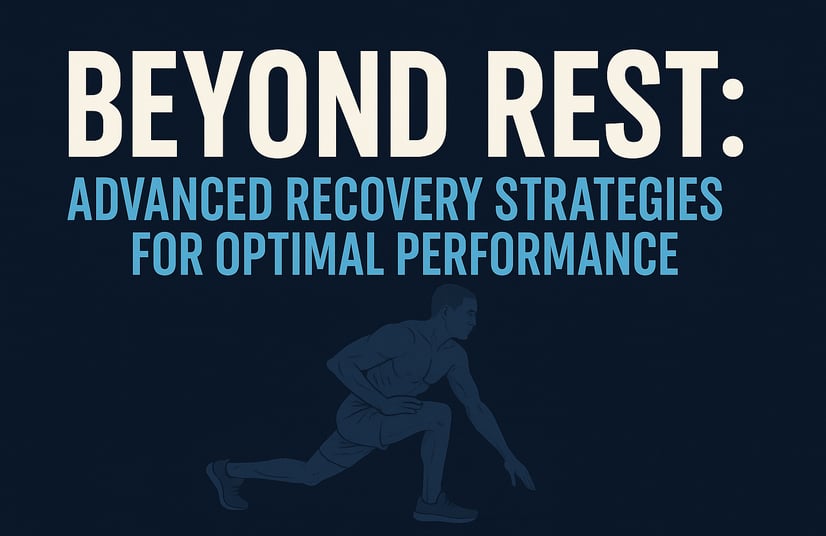Beyond Rest: Advanced Recovery Strategies to Boost Performance and Prevent Burnout
Most fitness advice stops at sleep and protein, but real recovery goes further. Discover how active recovery, mobility work, and nervous system regulation can speed healing, reduce soreness, and unlock your peak performance.
5/16/20253 min read


Beyond Rest: Advanced Recovery Strategies for Optimal Performance
Most people think recovery is just about getting more sleep and eating protein. And while those are important, the truth is: if you’re training hard and only relying on rest, you’re leaving serious performance gains on the table. Recovery is more than just “doing nothing.” In fact, some of the most effective recovery tools involve doing just enough—enough to help your body flush out fatigue, reset your nervous system, and keep you moving pain-free.
Let’s break down the recovery techniques that actually take your performance to the next level—going beyond sleep and nutrition.
Active Recovery: Move, Don’t Sit
Your muscles don’t recover best when you’re parked on the couch. Low-intensity movement, like walking, cycling, swimming, or even a slow jog, helps increase circulation, flushes out waste products like lactic acid, and delivers fresh oxygen to your tissues.
According to a study published in the Journal of Sports Science & Medicine, athletes who performed low-intensity activity 24 hours after intense workouts had less muscle soreness and recovered faster compared to those who rested completely.
Here’s how to apply it:
Do 15–30 minutes of light cardio the day after a hard workout.
Aim for a low heart rate zone, where you can breathe through your nose and still hold a conversation.
Pair it with mobility drills or breathwork for extra benefit.
Mobility and Myofascial Work: The Secret Weapon for Long-Term Gains
One of the most overlooked aspects of recovery is taking care of your fascia—the connective tissue around your muscles. When fascia gets stiff, your range of motion drops, your body compensates in bad ways, and eventually, injury follows.
That’s why foam rolling and mobility training are essential. A 2021 meta-analysis confirmed that foam rolling for 90 seconds per muscle group helped reduce delayed onset muscle soreness (DOMS) and even improved flexibility in the short term.
You don’t need a ton of time or equipment. A few of the best areas to target include:
Glutes and IT band
Calves
Thoracic spine
Quads and hip flexors
What’s key is consistency. Doing just 10 minutes of foam rolling and mobility work a few times a week can significantly improve how you feel and move—especially when stacked with light movement.
Recovery Tool Highlight:
TriggerPoint GRID 1.0 Foam Roller
This foam roller mimics the hands of a massage therapist, and its dense grid pattern really helps break up tension and increase circulation. It’s one of the most durable and effective foam rollers on Amazon—perfect for daily use.
Parasympathetic Activation: Calm Your Nervous System, Heal Faster
Here’s a recovery trick most people never talk about: if you’re constantly in fight-or-flight mode, your body won’t recover well—no matter how clean you eat or how long you sleep.
To truly repair tissue, your body needs to switch into parasympathetic mode—the “rest and digest” state. This system is controlled by your vagus nerve, and activating it can literally speed up recovery at a hormonal and cellular level.
Here’s how to activate it:
Deep belly breathing: Inhale for 4 seconds, exhale for 6. Do this for 5–10 minutes.
Cold exposure: Brief cold showers or targeted cold packs can help calm inflammation and activate parasympathetic tone.
Guided meditation or yoga nidra: Just 10 minutes can trigger a full nervous system reset.
Another underrated tool? Massage guns. Not only do they improve circulation and muscle relief, but they also promote a calming response when used gently over major muscle groups. Instead of hammering sore muscles, try using a massage gun slowly, in long strokes, while breathing deeply.
Recovery Tool Highlight:
Opove Apex Massage Gun
This thing is powerful but surprisingly quiet. With multiple attachments and a solid battery life, it’s perfect for both deep muscle work and lighter, calming sessions.
Keep Recovery Portable and Consistent
Sometimes you’re at work, in the car, or traveling—so a full foam rolling or cold shower session isn’t happening. That’s why it’s helpful to have something portable and quick to use to keep recovery consistent even when life gets busy.
A compact percussion device can be a game-changer. Keep it in your gym bag or next to your work desk. A 3–5 minute session on your traps, quads, or calves can make a huge difference, especially if you’re training multiple times a week.
Recovery Tool Highlight:
Sharper Image Powerboost Deep Tissue Massage Gun
Compact, quiet, and powerful. It’s easy to travel with and perfect for those quick midday resets or post-class recovery sessions.
Final Thoughts
If you want to optimize performance, avoid burnout, and feel strong every day—not just after a rest day—you need to treat recovery as seriously as your workouts. That means:
Prioritizing movement-based recovery
Doing regular mobility and myofascial work
Learning how to switch on your parasympathetic nervous system
The best athletes in the world aren’t the ones who train hardest—they’re the ones who recover smartest.
So don’t just rest. Recover with intention.
FITNESS
Nutrition
WellnesS
info@movebetterco.com
© 2025. All rights reserved | Privacy Policy | Terms & Conditions